In this comprehensive guide, we’ll explore:
- Customer Satisfaction Survey Questions
- Best Practices for Creating Customer Satisfaction Surveys
- The Importance of Customer Satisfaction Surveys
- What is a customer service satisfaction survey?
- How can I measure customer satisfaction?
- Customer Feedback Questions
- How To Use Customer Satisfaction Survey Results
- Customer Satisfaction Survey Template
- Customer Satisfaction Survey Examples from Real Brands
- Start Gathering Customer Feedback Today
The Importance of Customer Satisfaction Surveys
Customer satisfaction surveys help businesses better understand and utilize the voice of the customer to sustain growth. Several key reasons, above and beyond this overarching goal, make customer satisfaction surveys a top priority for customer-centric businesses.
1. Identifying negative themes in the customer experience.
By conducting customer satisfaction surveys, companies can pinpoint negative themes that customers are having and work to resolve them. When taken to hear, I’ve seen how feedback helps improve the overall customer experience and increases customer loyalty.
2. Identifying customer trends.
Surveys allow companies to identify trends in customer satisfaction over time. For example, if several customers have the same complaint about a product, there may be a shift happening in the market that your business hasn't noticed yet.
Acting on this feedback can keep your business ahead of the curve. I’ve noticed that brands who respond proactively can prevent customer turnover and get new folks to join who enounter the same issue with a competitor.
Companies that regularly conduct customer satisfaction surveys and make adjustments based on feedback are likely to outperform their competitors. This is because they are better able to meet customer needs and expectations.
3. Validating business decisions.
Customer opinions and feedback are two of the most essential factors that validate decisions within your business, allowing you to become more equipped to meet their needs. The product improvements your team spends money on, where you hire, and other expensive strategic moves can then be based on data.
What is a customer service satisfaction survey?
A customer service satisfaction survey is a tool to collect customer feedback regarding their experience with your customer service department. Customer service satisfaction surveys are designed to measure customer satisfaction levels, of course. However, they can also identify areas for improvement in your service department and uncover product areas that need attention.
Your customer service team is likely the department with the highest level of customer touchpoints, so understanding what drives customers to call and how their questions are handled is invaluable information when it comes to iterating on feedback and meeting customer expectations.
How can I measure customer satisfaction?
There are plenty of ways to measure customer satisfaction, and they all come down to asking customers how they feel. You are probably familiar with customer satisfaction surveys. Typically, you’ll receive an automated email after a purchase or customer service interaction asking you to complete a survey or rate your experience from 1-10 and explain why.
Plenty of survey software can do this, including HubSpot’s Service Hub. However, you don’t have to pay for customer survey software if you’re not at that stage in your business. I’ve used Google Docs to create feedback forms for my customers, which is a free and easy way to gather feedback and get a feel for customer satisfaction.
I also like to measure customer satisfaction the old-fashioned way: speaking to customers. I’ve had a lot of success asking customers, “How was everything?” after a gig (I rent music gear). You can build rapport, get an accurate feel for customer satisfaction and improvement areas, and solidify repeat business by talking with customers.
Customer Satisfaction Survey Questions
- What is your level of education?
- What is your approximate annual household income?
- Where do you work and what’s your job title?
- What industry are you in?
- What’s your most important priority when (insert something related to your industry)?
- What’s your biggest roadblock when (insert something related to your product)?
- On a scale of 1 to 10, how satisfied are you with your in-store experience today?
- How likely are you to recommend (insert product or service) to others?
- Rate your satisfaction with our team in resolving your issue.
- Did you feel that our team answered your inquiry promptly?
- Do you agree or disagree that your issue was effectively resolved?
- How likely are you to purchase again from us?
- How likely are you to return to our website?
- In your own words, describe how you feel about (insert company name or product here).
- How can we improve your experience with the company?
- What's working for you and why?
- What can our employees do better?
- How can our employees better support your business’s/your goals?
- How can we improve your experience with the website or the in-store location?
- Why did you choose our product over a competitor’s?
- What would be one word you’d use to describe us and why?
- May we contact you to follow up on these responses?
- In the future, would you be willing to take this survey again?
- If we were to update (insert product feature here), could we reach back out to talk about these changes?
- Can we connect you with a customer success manager via chat?
- Would you be open to discussing upgrade options for your product?
- Can we send you a list of useful resources for getting the most out of your product?
- How long have you been using the product?
- Which alternatives did you consider before purchasing the product?
- How often do you use the product or service?
- Does the product help you achieve your goals?
- What is your favorite tool or portion of the product or service?
- In your own words, describe how you feel about (insert company name or product here).
- How can we improve your experience with the company?
- What's working for you and why?
- What can our employees do better?
- How can our employees better support your business’s/your goals?
- May we contact you to follow up on these responses?
- In the future, would you be willing to take this survey again?
- If we were to update (insert product feature here), could we reach back out to talk about these changes?
Net Promoter Score (NPS) Surveys and Customer Loyalty Questions
Note: NPS is a critical SaaS metric used to measure customer satisfaction.
- On a scale of 1 to 10, how satisfied are you with your in-store experience today?
- How likely are you to recommend (insert product or service) to others?
- How likely are you to purchase again from us?
- How likely are you to return to our website?
- In your own words, describe how you feel about (insert company name or product here).
- How can we improve your experience with the company?
- In the future, would you be willing to take this survey again?
- May we contact you to follow up on these responses?
- Would you consider our product/service a good value for the price?
- How would you rate your overall satisfaction with our customer service?
- What aspects of the product/service were you most satisfied with?
- What was the primary reason for choosing our product/service?
- What other products/services would you like to see us offer?
Questions for Collecting Product Feedback
- What’s your biggest roadblock when (insert something related to your product)?
- What would be one word you’d use to describe us and why?
- If we were to update (insert product feature here), could we reach back out to talk about these changes?
- How long have you been using the product?
- Which alternatives did you consider before purchasing the product?
- How often do you use the product or service?
- Does the product help you achieve your goals?
- What is your favorite tool or portion of the product or service?
- What features do you find most useful?
- What features do you feel are lacking or could be improved?
- How does our product compare to others you’ve used in the past?
- What is the one thing that would make you use our product more often?
- How easy is it to use our product?
- Do you feel our product is tailored to your needs?
- Is there anything about our product that surprised you?
- How well does our product/service meet your needs?
- What could we do to make you more likely to recommend us?
Questions About Customer Support
- Rate your satisfaction with our team in resolving your issue.
- Did you feel that our team answered your inquiry promptly?
- Do you agree or disagree that your issue was effectively resolved?
- What can our employees do better?
- How can our employees better support your business’s/your goals?
- What mode of communication do you prefer when reaching out for support?
- How do you rate the accessibility of our customer service?
- Are there additional training or resources you wish our team had?
- How well does our customer support team understand your issues?
- What do you generally think of the wait times?
- Do you feel our support team is knowledgeable and competent?
- Would you describe our customer service as personalized?
- Do you feel the customer support team fully understood your needs and goals?
- Would you prefer to solve issues on your own using knowledge base resources?
Marketing Research Questions
- What is your level of education?
- What is your approximate annual household income?
- Where do you work, and what’s your job title?
- What industry are you in?
- What’s your most important priority when (insert something related to your industry)?
- Why did you choose our product over a competitor’s?
- How do you generally learn about new products in our industry?
- What kind of advertisements catch your attention?
- Do you follow us on social media?
- What factors influence your purchasing decisions the most?
- How important is brand reputation in your buying decision?
- What do you think about our pricing compared to competitors?
- What trends are you noticing in our industry that are important to you?
- How did you hear about us?
Additional Engagement and Research Questions
- What's working for you and why?
- How can we improve your experience with the website or the in-store location?
- Can we connect you with a customer success manager via chat?
- Would you be open to discussing upgrade options for your product?
- Can we send you a list of useful resources for getting the most out of your product?
- What additional support can we offer to enhance your experience?
- Would a loyalty program encourage more frequent purchases or interactions?
- How responsive do you find our online platforms?
- Would more frequent updates or newsletters be helpful?
- How personalized do you feel our communications are?
- What elements of our service exceed your expectations?
- Would you recommend us to a colleague?
- Is there anything else you’d like to share with us?
If you want to obtain valuable feedback from your customers, then you have to ask them the right questions. Sharing information isn‘t always an easy task, and it’s not the customer‘s job to provide your business with constructive criticism. Instead, it’s the surveyor's responsibility to create a thought-provoking prompt that engages the participant.
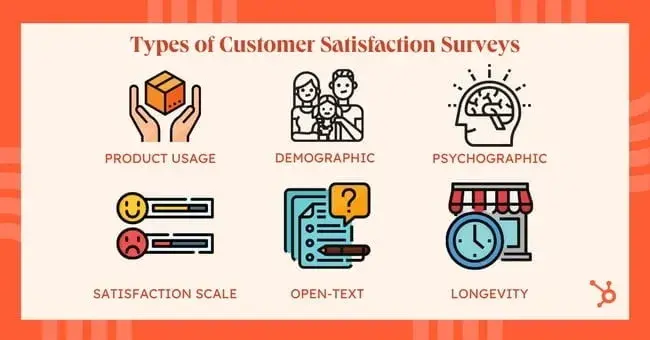
Customer Feedback Questions
To get the most out of valuable customer feedback, you’ll need to make sure you’re asking the right questions. Open-ended questions are a great way to gain more thorough explanations about your customer’s experience with your brand, but they’re not the only types of questions you can ask.
If you're getting stuck on deciding what to ask your customers, here are some of the types of questions we recommend including on your customer satisfaction survey:
Product Usage
When it comes to customer success and satisfaction, your business must collect feedback about your product or service. If you don‘t, then it’s more difficult to assess customer needs and provide effective solutions.
Finding out how satisfied your users are with your offer provides your marketing and product teams with valuable information that can be used to improve customer retention.
Some questions that you could ask in this section are:
- How long have you been using the product?
- Which alternatives did you consider before purchasing the product?
- How often do you use the product or service?
- Does the product help you achieve your goals?
- What is your favorite tool or portion of the product or service?
- What would you improve if you could?
- Which product features do you consider the most valuable?
- Which product feature do you use most often in your day-to-day?
- What points of friction have you encountered while using the product?
- If there was one new feature you could suggest, what would it be and why?
Demographics
Demographics are essential to marketing and sales teams because they make it easier for companies to segment customers into buyer personas. By grouping customers based on key characteristics, this categorization helps employees visualize their target audience. Marketing and sales teams can then use that information to pursue leads that are most likely to convert.
When asking these types of questions, be sure to embrace a proactive and inclusive approach. These questions shouldn‘t be mandatory, so always provide an option for customers to omit an answer. Your goal is to extract honest information, but you don’t want it to come at the expense of the customer's comfort.
Here are some demographic questions that you should consider including in your next survey:
- How old are you?
- Where are you located?
- If applicable, what gender do you identify as?
- What is your employment status?
- What is your marital status, and do you have children?
- What is your level of education?
- What is your approximate annual household income?
- Where do you work, and what’s your job title?
- What industry are you in?
Psychographics
Psychographic questions dig deeper than demographic questions, uncovering information relating to your customers’ preferences, habits, behaviors, and tendencies. It’s not about who your customer is, but why they do what they do.
Psychographic questions may seem intrusive, but they’re highly valuable pieces of information that give you a glimpse into the reasons for your customer’s buying habits. They’re usually phrased concerning your industry and not specifically about your product.
These questions are instrumental in customer satisfaction surveys because you can indirectly find out how you can better serve your customers.
Here are a few questions you might ask:
- Do you prefer to shop on your phone or your laptop?
- What’s your most important priority when (insert something related to your industry)?
- For example, if you’re a mortgage lender, you might ask, “What’s your most important priority when buying a home?”
- What’s your biggest roadblock when (insert something related to your product)?
- For example, if you’ve created a recipe-sharing app, you might ask, “What’s your biggest roadblock when trying to access the best recipes online?”
- How much time do you spend on (insert social media platform you’d like to use for advertising)?
- How much does sustainability matter to you when purchasing a product?
- How do you feel about (insert product type)?
- For example, if you sell women’s razors, you might ask, “How do you feel about women’s razors?”
- What do you dislike about (insert product type)?
- How many hours a day do you spend doing (insert something that relates to your product)?
- For example, if you sell ergonomic car seats, you might ask, “How many hours do you spend driving?”
Satisfaction Scale
Sometimes, there are aspects of your offer or business that you want feedback on, but they aren't things that your customers are actively addressing. In these cases, it helps to be direct and ask customers how they feel about these specific details.
Before you do, you'll have to determine a quantifiable way to measure their responses. Adopting a satisfaction scale section is a great way to create a consistent approach to quantifying this subjective survey feedback. A few ways that you can implement this scale are:
- A scale measuring from 1 to 10 (or another number). One means the customer was extremely unsatisfied, and 10 means the customer was very satisfied.
- A descriptive scale that measures a customer's response from unsatisfied to satisfied. The customer is given a shortlist of responses to choose from that range from “very unsatisfied” to “very satisfied."
- A picture scale that uses images to symbolize customer satisfaction. For example, you can use happy, sad, and indifferent emojis to quickly gather customer feedback.
Example questions include:
- On a scale of 1 to 10, how satisfied are you with your in-store experience today?
- How likely are you to recommend (insert product or service) to others?
- Rate your satisfaction with our team in resolving your issue.
- Did you feel that our team answered your inquiry promptly?
- Do you agree or disagree that your issue was effectively resolved?
- How likely are you to purchase again from us?
- How likely are you to return to our website?
Open-Text
Open-text questions are survey questions that allow the participant to write out their response within a text box. This allows users to fully express their opinions using the customer's voice instead of the company's pre-written responses.
While they can sometimes be time-consuming to analyze, these questions encourage the participant to be honest and give them the freedom to address any topic. Open-text questions can be an instrumental asset when determining the core values of your customers.
Here are open-text questions you can ask in your next survey:
- In your own words, describe how you feel about (insert company name or product here).
- How can we improve your experience with the company?
- What's working for you and why?
- What can our employees do better?
- How can our employees better support your business’s/your goals?
- How can we improve your experience with the website or the in-store location?
- Why did you choose our product over a competitor’s?
- What would be one word you’d use to describe us and why?
- Do you have any additional comments or feedback for us?
Longevity
In the last section of your survey, you‘ll want to include questions about the steps that’ll happen after submission. These questions permit your team to follow up with the participant in the future.
This comes in handy when you roll out changes and want to get updated feedback from the same customers who were surveyed earlier. You can phrase these types of questions in a few different ways:
- May we contact you to follow up on these responses?
- In the future, would you be willing to take this survey again?
- If we were to update (insert product feature here), could we reach back out to talk about these changes?
- Can we connect you with a customer success manager via chat?
- Would you be open to discussing upgrade options for your product?
- Can we send you a list of useful resources for getting the most out of your product?
While measuring customer satisfaction can be tricky to manage, asking effective questions can reveal highly valuable customer insights — and the questions we’ve listed above will do the trick.
Next, I’ll go over best practices for creating customer satisfaction surveys.
Best Practices for Creating Customer Satisfaction Surveys
- Make sure you choose the right survey tool.
- Always ask short and relevant survey questions.
- Send the surveys at the right time.
- Always A/B test your surveys.
- Thank your customers for their feedback.
Designing a customer satisfaction survey is no easy task. But, as Ian Schafer, founder of Deep Focus says, “Innovation needs to be part of your culture. Customers are transforming faster than we are, and if we don’t catch up, we’re in trouble.”
Luckily, there are a few best practices that will help you increase response rates and get much-needed feedback from your customers to get started.
1. Make sure you choose the right survey tool.
Choosing the right survey tool is essential because it can significantly impact the quality of your results.
A good survey tool should be easy to use, customizable, and provide in-depth analytics. It should also have the ability to automate survey distribution and analysis.
HubSpot’s Service Hub offers a powerful, easy-to-use survey solution to track customer satisfaction and visualize data in beautiful, ready-made charts.
Without the right survey tool, you’ll have a whole lot of data and no way to distill it or glean valuable insights from it. Choose a tool that allows you to ask different questions, examine basic metrics such as response rates, and track customer sentiment over time.
Pro tip: When choosing a survey tool, prioritize mobile-first design. Why? Because more and more people are taking surveys on their smartphones. A survey optimized for mobile will ensure higher completion rates and more accurate data.
2. Always ask short and relevant survey questions.
No one enjoys spending a lot of time answering surveys, so be sure to keep your survey questions short and to the point. Asking short and relevant survey questions is the key to earning high completion rates. Long and complex survey questions can be overwhelming and may discourage customers from providing any feedback at all.
On the other hand, shorter questions allow customers to easily comprehend what is being asked and are more likely to provide accurate responses. When asking open-ended questions, keep the minimum character count short, make the question optional, or offer an incentive.
Pro tip: Use branching logic to personalize the survey experience and keep it concise. This allows you to show respondents only the questions that are relevant to them based on their previous answers. It also prevents them from wasting time on irrelevant questions, significantly improving the survey experience.
3. Send the surveys at the right time.
Give a lot of thought to the placement of your surveys throughout the customer journey. It wouldn’t make sense to send a survey to someone who’s only just subscribed to your blog — nor would it make sense to send one year after a customer stopped doing business with you.
Sending surveys at the right time is critical to getting accurate feedback. Customers are more likely to provide feedback when they are in a position to evaluate their experience with your company.
When do you send a customer service survey? Send it after a lengthy interaction with one of your teams, a few weeks after purchase or onboarding, and a few times throughout the year to measure the customer’s happiness.
Pro tip: To maximize responses, make sure you’re sending surveys at the optimal time. Trigger them based on specific customer actions, such as immediately after a purchase or following a support interaction. This ensures you capture feedback while the experience is still fresh in their mind, leading to more accurate insights and higher response rates.
4. Always A/B test your surveys.
A/B testing is an excellent way to find out whether your surveys are as effective as they can be. Simply create two versions of the survey with minimal changes. You can change the order of the questions, the number of questions, the wording, and even the color of the buttons. (Change only one thing at a time so you can accurately measure its impact on the survey.)
By comparing the results of each version, you can determine which version yields the highest response rate and provides the most accurate feedback. This can help you refine your survey strategy and improve the overall quality of your survey data.
Pro tip: A/B test your survey length to find the sweet spot between gathering enough data and respecting your respondents’ time. While you want comprehensive feedback, lengthy surveys can lead to respondent fatigue and lower completion rates. Finding the optimal length ensures you get valuable data without overwhelming your audience.
5. Thank your customers for their feedback.
Thanking customers for their feedback is important to show that you value their opinion and are committed to improving the customer experience. It also helps to improve customer loyalty and increases the likelihood that they will provide feedback in the future.
Whether it’s through a gift card, a discount, or simply a nice email, always thank the customer for their time, regardless of the nature of the feedback.
By thanking customers for their feedback, you signal that you take their opinions seriously and are committed to addressing their concerns. This can help you maintain strong relationships with your customers and drive long-term business success.
Ready to craft your own customer satisfaction survey? Use the template in the next section to get started.
Pro tip: When possible, close the feedback loop by informing customers how their input is being used. Letting them know that their suggestions led to a product improvement or a change in your customer support process demonstrates that their opinions are valued and they’re more likely to participate in future surveys. For example, you could say, “Thanks for your feedback, we’ve simplified our checkout process to make it faster and more user-friendly.”
How To Use Customer Satisfaction Survey Results
1. Define customer segments.
Customer satisfaction surveys can be used to segment customers based on their preferences. With these survey results, you can tailor your approach to specific customer groups and provide more personalized experiences.
2. Track customer satisfaction over time.
Identifying changes in customer sentiment can be difficult if you don't have multiple data points over a long period of time. Regular customer satisfaction surveys can be used to track this and address issues before they become systemic problems.
3. Benchmark against competitors.
Customer satisfaction survey results can be used to benchmark your company’s performance against competitors. This way, you'll identify areas where your company may be falling short and implement changes to improve your standing in the market.
Customer Satisfaction Survey Template
The following customer satisfaction survey template can help you get answers from your customers in one easy step. It asks one simple question: “How satisfied were you with your experience today?” If you’d like, you can add more questions to get more details from your customers.
To make a copy of this template and get four bonus templates, click here.
Now, you’ve got a template and are ready to create your customer satisfaction survey. In need of some inspiration? Take a look at these examples from different companies.
Customer Satisfaction Survey Examples from Real Brands
I’ve covered why asking for customer feedback is important and the types of questions to include, but you still might be wondering how to put it all together. Let’s check out the customer feedback example questions below from real companies to gain insight into how to roll out a survey of your own.
1. HubSpot
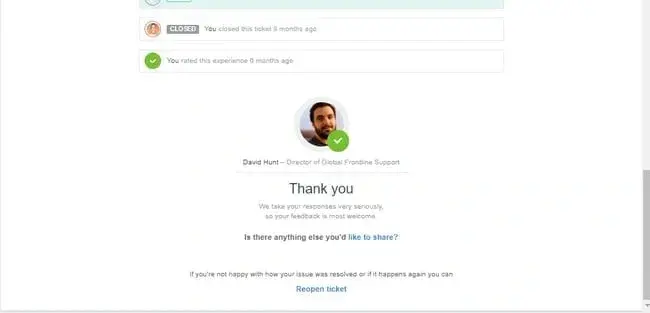
At HubSpot, we use NPS surveys to assess customer satisfaction. This score primarily comes into play with customer support and success teams, who can be reviewed after each new interaction.
Our engineers then use these responses to address areas in the software that could use improvement. By using this scoring system, we’re able to gather both qualitative and quantitative data to direct our product development efforts.
What I like: As a writer for HubSpot, I like how the company uses its surveys to create product-level improvements, and the best part is that for customers, answering one question is an effortless way to give feedback. So it’s a win-win for both sides. Close the feedback loop by routing survey responses to the right departments, enabling swift action on customer issues and suggestions.
2. Airbnb
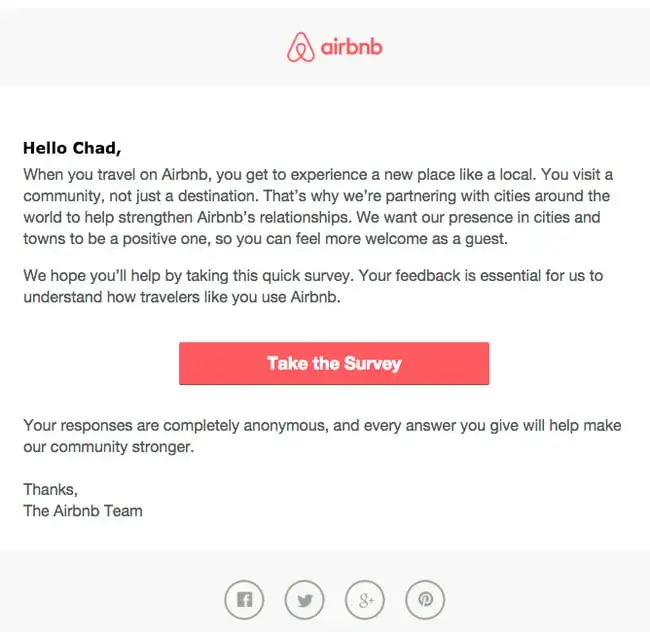
Airbnb lets customers book overnight stays and experiences across the world. For Airbnb hosts to build a reputation, they rely on customer feedback to make them seem more credible.
In this survey example, Airbnb includes an eye-catching button that prompts recipients to take the survey. Once they click through, they’re taken to a user-friendly survey with a series of questions that can help Airbnb better understand why the recipient chose Airbnb as their provider. It’s extremely in-depth, too, prompting customers to provide as much detail as possible about their experience.
What I like: Airbnb politely asks for customers’ opinions after their stay, giving them the space to decide whether they want to share feedback or not. In its survey request, Airbnb was intentional about the design of the button, too, by choosing an eye-catching brand color that entices people to click. Your survey invitation emails should have a call-to-action button, just like a marketing email would, to increase click-through-rate.
3. Hilton Hotels
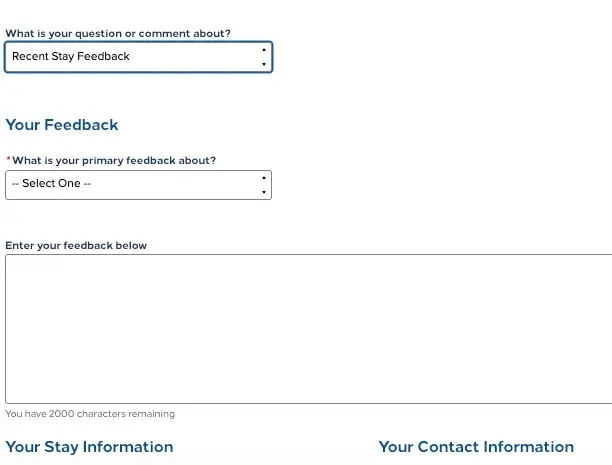
The Hilton Hotel company provides its customers with promising customer service, upholding its century-old reputation.
To better understand what people’s stays were like, it offers a one-page survey where customers can willingly submit their feedback. It’s just a few questions long, most of which are logistical (such as where the visitor stayed and how long they stayed there). Users then have the option of elaborating.
What I like: This seemingly simple survey from Hilton gives unhappy guests an easy, friction-free opportunity to submit feedback about their recent stay. It’s hosted on a public URL that guests can access without needing to get through any barriers. The questions are simple and easy to answer.
4. Uber

Uber has two target audiences — the drivers and the passengers — and it does a great job collecting opinions and reviews from both. The passengers give ratings after every ride, and the drivers rate the passengers as well.
What I like:This survey makes it fair and transparent for both the driver and the passenger, and these ratings affect both parties’ reputation as well. If a passenger has a lower rating, the driver has the authority to decline the booking. If you run a business with two target audiences, create a survey for both.
5. Cisco
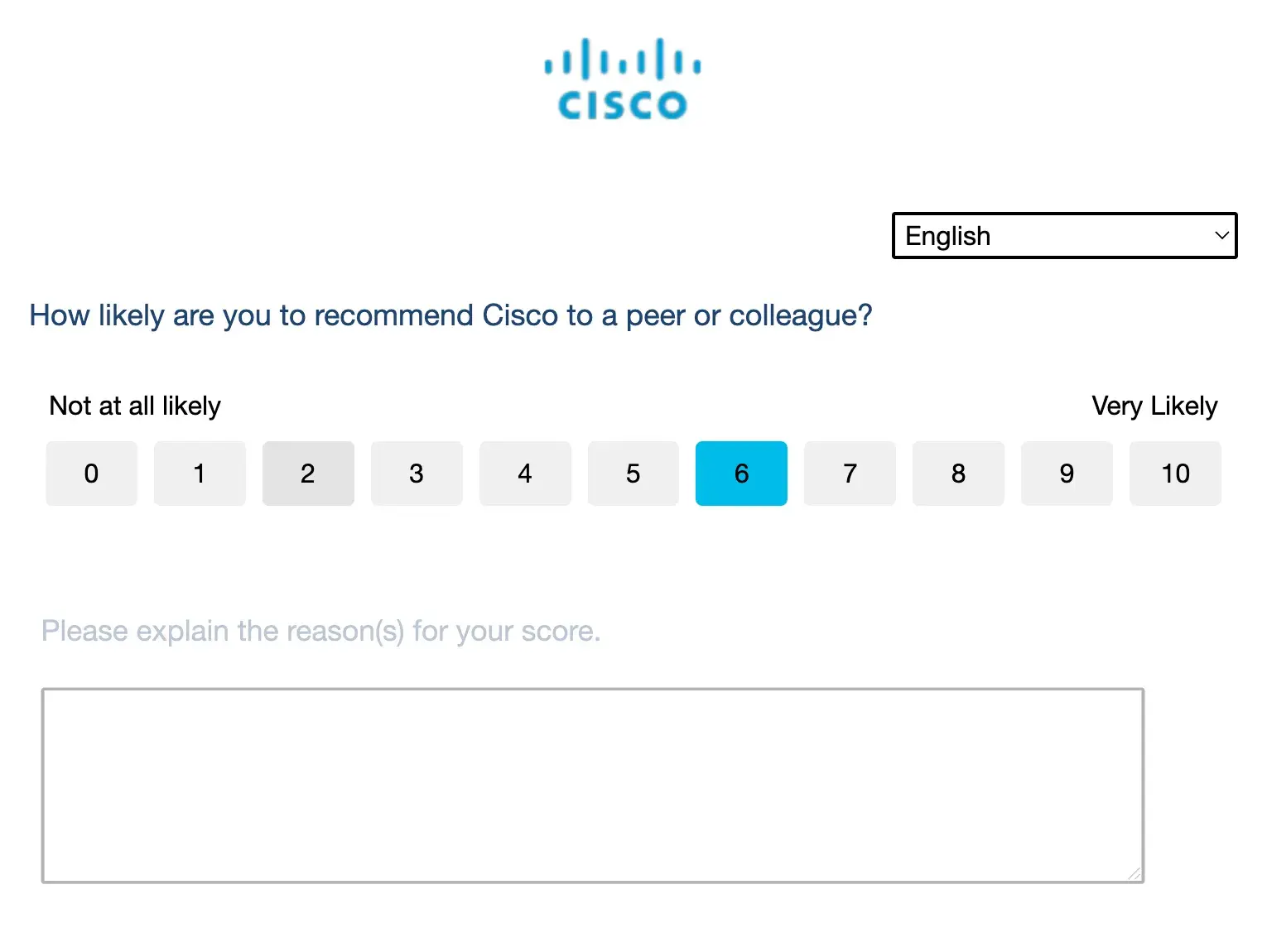
While Cisco products are essential to businesses, surveys are still essential. Getting user feedback can help the company improve its products and prevent buyers from jumping ship for an emerging option. That’s why customer satisfaction matters.
I like the simplicity of this survey. First, the survey asks me to explain my level of satisfaction. I can then provide optional written feedback. If I’m very busy, this survey is low-lift, and I can stop there.
However, the next question asks if I have three minutes to answer more questions. I then get a more thorough survey that asks me to rate the different areas of my customer experience (purchasing, working with the solution itself, and receiving post-purchase support).
What I like: In this survey, Cisco understands that its users are busy. The different survey pathways guarantee that more people actually fill out the form. Then, the brand benefits from both quick, pulse-check data and more in-depth feedback.
6. Slack
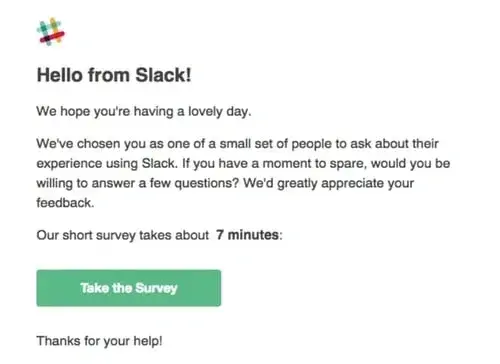
Slack is a business messaging app that helps professionals connect from anywhere. It bases its product development entirely on customer feedback.
In fact, customer feedback is at the epicenter of its efforts. For instance, there's a command within the application where users can send feedback to the Slack team or just tell them what features the users would like to have. The co-founders read all the user feedback and made sure they responded to every ticket raised.
In the email above, Slack invites the user to take a survey to improve its offering. The email is short and to the point.
What I like: Slack’s commitment to collecting customer feedback is commendable, and so are its invitations to take the survey. In the above example, Slack makes the survey seem more exclusive by mentioning that it was only sent to a few people. Don’t be afraid to curate a short list of customers to send the survey to, especially if it seems like those customers would be more likely to answer.
7. Apple Watch

Apple understands the importance of a positive customer experience. They’re employing a net promoter score survey to gauge customer satisfaction with the Apple Watch try-on experience.
The survey has one question, “How likely are you to recommend the Apple Watch try-on experience…to a friend or family member?” With such a powerful query, Apple can gather valuable data on customer sentiment and brand advocacy. Sometimes, a single question is all it takes to measure the effectiveness of a retail strategy and identify areas for improvement.
What I like: Paytm gives users the opportunity to tangibly improve the product by giving them the ability to report bugs directly on the app. Plus, it not only collects customer feedback. It acts on it, too, by fixing those bugs. Overall, Paytm provides plenty of avenues for turning an unhappy customer into a happy one.
8. Paytm
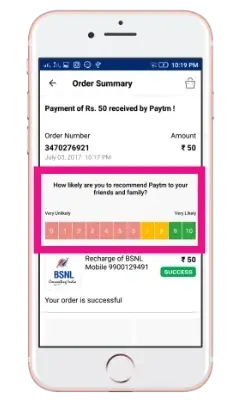
Paytm has always taken customer opinions into account and has taken serious steps to improve the customer experience.
Taking customer experience and security to another level, Paytm has created a “bug bounty” to catch fraudulent merchants. If customers accidentally buy fake movie tickets through the platform, for example, Paytm allows them to get refunds on their bookings.
What I like: Paytm gives users the opportunity to tangibly improve the product by giving them the ability to report bugs directly on the app. Plus, it not only collects customer feedback, it acts on it, too, by fixing those bugs. Overall, Paytm provides plenty of avenues for turning an unhappy customer into a happy one.
9. Carbon Health

Email isn’t the only way to get user feedback. After a recent doctor’s appointment, my friend received a follow-up survey about her business. Just like the appointment reminders and scheduling confirmation, the survey came through SMS. Beyond that, my friend didn’t need to go anywhere to respond. She just had to text back a rating.
This method works if your users recognize your number or your brand. If you don’t have a text relationship with your customers, they might think your text is spam. Do not include external links to avoid confusion.
What I like: If your customer already engages with you over text, text-based surveys are the way to go. I love how this survey is simple, sticks to one question, and doesn’t require clicking to another page.
10. Amazon

Amazon, one of the most popular eCommerce websites in the world, truly exemplifies what it means to be customer-centric. As Jeff Bezos famously said, “We see our customers as invited guests to a party, and we are the hosts. It’s our job every day to make every important aspect of the customer experience a little bit better.” This philosophy is woven into the fabric of Amazon’s operations.
They go above and beyond to exceed user expectations by collecting all kinds of information. For instance, after you contact their customer service department, they send a customer feedback survey with targeted questions about your interaction:
- Please rate the service provided by the Amazon representative.
- Please rate how well you could understand the Amazon representative.
- Anything else to add?
But Amazon doesn’t stop there. They understand that a seamless customer experience goes beyond just surveys. By making information easily accessible in a knowledge base, they empower users to find answers and troubleshoot on their own.
This proactive approach reduces the chances of incorrect purchases and promotes informed buying decisions, illustrating how a commitment to continuous improvement, fueled by customer feedback and readily available information, can significantly elevate the customer experience.
What I like: I appreciate Amazon’s CSAT survey because it proactively addresses a key gap in customer interactions. I’ve noticed that customers often reach out only when they’re unhappy, and surveys like these ensure their voices are heard after an issue is resolved. I admire how this approach helps gauge whether the resolution restored the customer’s satisfaction, offering valuable insights to improve service.
10. X
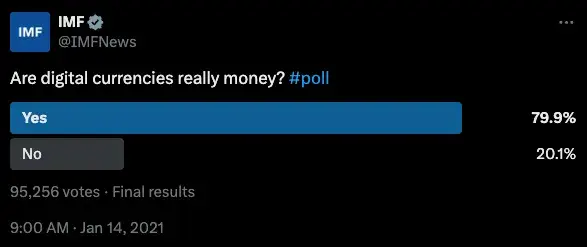
Not only is X (formerly Twitter) great for direct (personal) and public messages, but it's also working toward bridging the communication gap between brands and audiences. You can use the “Polls” feature to informally ask for customer feedback — or get more psychographic data about your target audience. This action is as simple as, well, making a post.
While this is not an example of an actual customer satisfaction survey, publishing an X Poll can be an excellent way to collect customer feedback quickly and effectively in an informal setting.
What I like: I love the Polls option for customer satisfaction surveys because it’s not a formal sit-down survey. Your followers can answer one question as they scroll through their feed, and you get feedback from those who are interested in your brand, too. It’s a great choice for asking more general brand sentiment questions as opposed to product-based questions.
11. Zomato
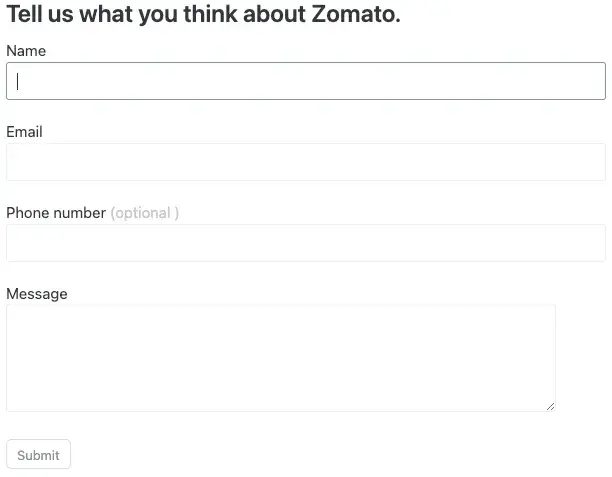
Zomato is one of the largest food delivery and review websites in the world, and its success can be largely attributed to customer satisfaction.
Another product with two types of audiences — restaurants and hungry diners — Zomato puts both their needs and expectations into consideration. Every restaurant gets rated on the food, and every buyer gets to rate the restaurant. In the above survey, it asks for feedback with one simple statement:
“Tell us what you think about Zomato.”
Then, it allows users to free-write their thoughts.
What I like: This open-ended survey format is perfect for websites and apps. You would ideally always include the option to give feedback in a pop-up button, banner, or tab that users can click. That way, you don’t need to contact users first; they can voluntarily submit feedback to you.
12. Greyhound
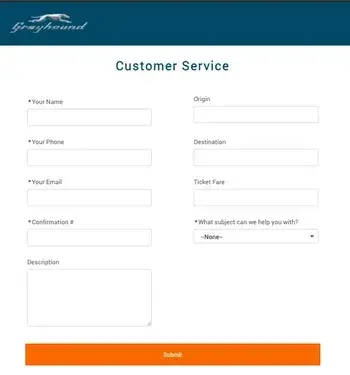
Here's a great example of a customer satisfaction survey from Greyhound. The questions measure both the qualitative sentiment and experience of interacting with the brand.
What I like: In such a crowded space, Greyhound needs to make sure that the service it‘s providing works for its customers — or else it’ll start losing them to competitors. This survey, deployed immediately after a trip, is a great way to measure satisfaction at the moment when it's most memorable for a customer.
13. H&R Block
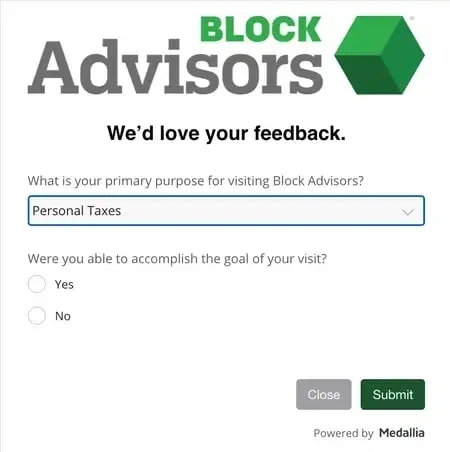
H&R Block Advisors sent another well-timed customer satisfaction survey — just after “Tax Season” in the U.S.
For accountants and financial advisors, the months before the tax filing deadline are the busiest, so a prompt survey after filing with H&R Block helps the company gauge how many returning customers it can expect.
What I like: I like that they intelligently schedule the survey at a busy time for their business. If your business also has busy periods or periods where people are more interested in your products, send surveys during those time ranges to optimize the amount of responses you receive. You’ll get more submissions simply because you have more customers during those months.
14. GEICO
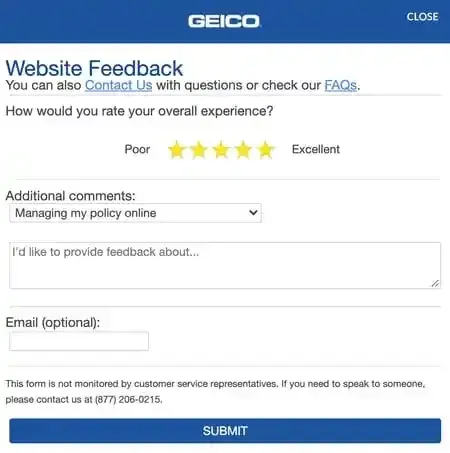
Measuring sentiment, in addition to satisfaction, is important when surveying your customers.
In this survey, GEICO asks about customer sentiment regarding a specific interaction during the purchase process — and the general feeling of the experience as well. In this way, GEICO can smooth out specific roadblocks throughout the customer journey, and get an in-the-moment snapshot of its wider customer sentiment.
What I like: I like that their example is simple, short, and to-the-point. It only has three questions and gives an additional avenue for contacting GEICO’s customer service team. Always give respondents a second option for submitting feedback or contacting your team to better gauge how satisfied they are with your brand.
16. Taco Bell
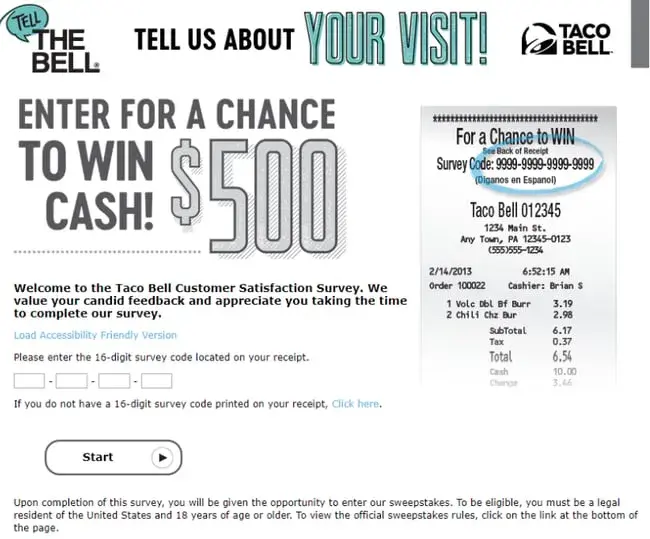
Well-known fast food company Taco Bell has made an outstanding commitment to gathering customer feedback.
Every receipt is printed with survey instructions that are placed in locations that are easily noticed. Taco Bell also incentivizes its customers by offering them rewards for filling out surveys, along with entering the participants into a raffle upon survey completion.
What I like: Taco Bell prompts its customers to complete the survey just by including a survey number in the receipt. There’s no need for Taco Bell to email the customer after a purchase. Most importantly, the company increases responses by offering a prize. Try to provide incentives and a link to the survey in a noticeable place.
17. Qualtrics
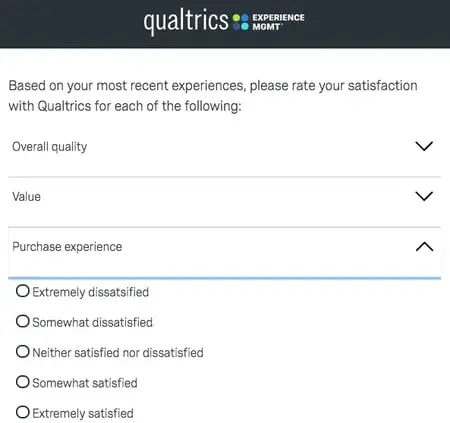
Qualtrics is a data-collection company that helps businesses gather data on their customers. It's no surprise that its customer satisfaction surveys are interactive and include plenty of features that keep participants engaged.
What I like: I like that each option has a dropdown menu where respondents can pick an answer to choose from. This keeps the survey‘s design short and sweet, making it less intimidating to someone who’s looking to complete it in just a few minutes.
18. HubSpot for WordPress

HubSpot for WordPress is a plugin that adds CRM functionalities, forms, and live chat to WordPress websites. In this survey, our aim is to find out whether the plugin has been working as designed. It has just one simple request: “Rate your experience using HubSpot for WordPress.”
I recommend using this format for product-related surveys — specifically those that have to do with a single specific feature. For instance, if you recently rolled out a new update, this single-question survey can help you measure your customers’ opinions about the new addition to their software or product.
What I like: The five-star scale is simple to understand and makes it easy to answer. The users can also answer straight in their email, instead of needing to access an external survey link. Sometimes, you don’t need to include complicated questions and options to create an effective customer satisfaction survey.
19. McDonald's
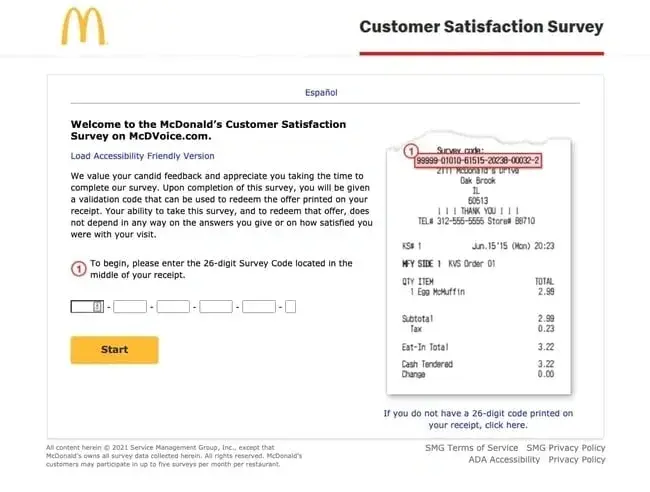
McDonalds is a fast food company that knows exactly how to cater to its customers, even deploying different strategies in countries across the world. One way it tracks success is through incentivized feedback.
What I like: One feature that stood out to me on this McDonald‘s survey was the labeled receipt on the right-hand side. The element is highlighted so participants know exactly what McDonald’s is asking them about in the corresponding survey. Not only does this ensure McDonald‘s gets accurate information from the survey, but it also reduces any friction customers may have if they’re unsure or confused about a question.
20. Home Depot
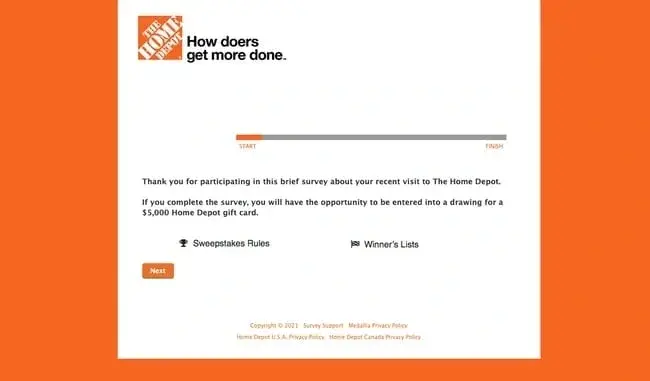
When customers go to hardware stores, they’re looking for a business that will satisfy their home renovation needs, and Home Depot delivers just that. It collects feedback from customers to improve its offerings and provide better service moving forward.
What I like: I like that to entice participants to take the survey, Home Depot offers a $5,000 Home Depot gift card. Offering a sweepstakes entry up-front is a great way to ensure that you get feedback from customers who are more likely to purchase from you again. If you weren’t interested in Home Depot, you wouldn’t take a $5,000 gift card. Right away, you get to gauge the customer’s continuing interest in your business.
21. Petco

Pet supply store Petco shows that it takes the customer experience seriously by sending store visit feedback surveys. The follow-up survey not only affirms the brand’s care of the customers’ pet, but asks a simple satisfaction question about a specific visit to a store location.
What I like: Petco’s feedback survey does a lot right, with a quick turn-around email survey that’s both on-brand and simple. Notice that you don’t have to navigate out of the email? All it requires is one click as you rate your store visit experience. I like that they think about your time and convenience.
22. Etsy
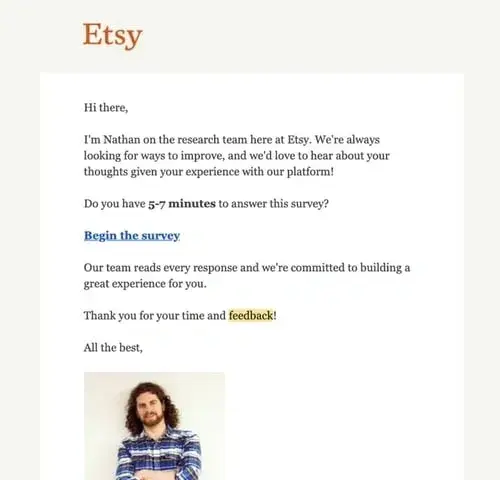
Etsy’s customer satisfaction survey takes a slightly different approach. Rather than sending the survey from a customer service rep’s email, it is sent from Etsy’s research team instead. Even more, a picture of the research team member is included at the end, making it easy to forge a human connection with the person who might actually read the survey responses.
Once you click on the link, you’re taken to an extensive survey that asks a multitude of questions. While shorter surveys are typically better, Etsy establishes the right expectations by sending the survey from the research team. This gives you the impression that the survey will be long and extensive, because it’s being used for research purposes.
What I like: I think Etsy’s example is a winner because it opens with a personal greeting from one of Etsy’s team members. Even if the email was mass-sent, that greeting immediately makes it feel more personal, and the picture of the Etsy staff member only personalizes it further. Lastly, if you plan to send a long survey, feel free to call it “research” to establish the right expectations.
23. Autonomous NYC (now Autonomous)
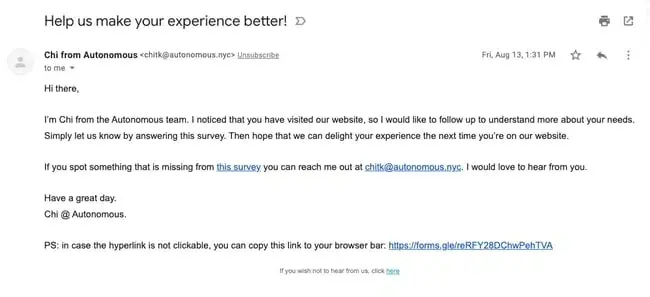
You don’t always need a polished, over-designed email to ask for feedback. Take a page from Autonomous’ playbook. They keep it simple and personal. If including a photo of yourself, like Etsy does, feels too formal, just use your first name to make the request more approachable.
Clicking their link takes you to a two-page Google Form survey designed to measure how happily users are with their website experience. It’s clear, straightforward, and quick to fill out –– exactly what you want in a feedback request.
What I like: Autonomous’ customer satisfaction survey hits all the right notes. I like that it’s short but not so short that Autonomous’ team can’t gather any insights. It also makes most questions optional so that users have the choice to walk away after answering two questions. Give the same option to your survey recipients by making at least a few of the questions optional.
Start Gathering Customer Feedback Today
Writing this article reminded me how important it is to really listen to your customers. In my experience, building a successful business hinges on understanding their needs, their pain points, and their aspirations. Customer satisfaction surveys are an invaluable tool in this process. They provide that direct line to your customers, allowing you to gather those essential insights that really fuel innovation and drive business growth.
By investing time and effort in understanding what your customers want and need, you can create experiences that foster loyalty and set your business apart from the competition.
Don’t just collect feedback –– act on it. Leverage the strategies and examples in this guide to gather meaningful feedback and transform it into actionable insights that drive your business forward.
Net Promoter, Net Promoter System, Net Promoter Score, NPS and the NPS-related emoticons are registered trademarks of Bain & Company, Inc., Fred Reichheld and Satmetrix Systems, Inc.
Editor's note: This post was originally published in May 2018 and has been updated for comprehensiveness.
Customer Satisfaction
.png?width=112&height=112&name=Image%20Hackathon%20%E2%80%93%20Horizontal%20(24).png)

.webp)

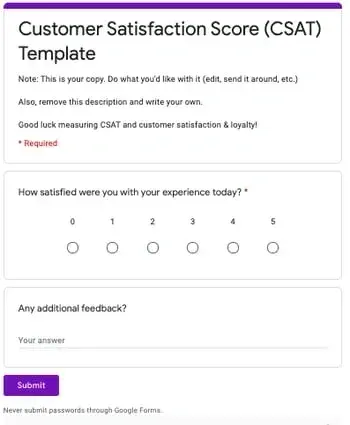

![Big Brands That Lost Customers' Satisfaction [Where CX Went Wrong + Data]](https://53.fs1.hubspotusercontent-na1.net/hubfs/53/companies%20that%20lost%20customers_featured.png)

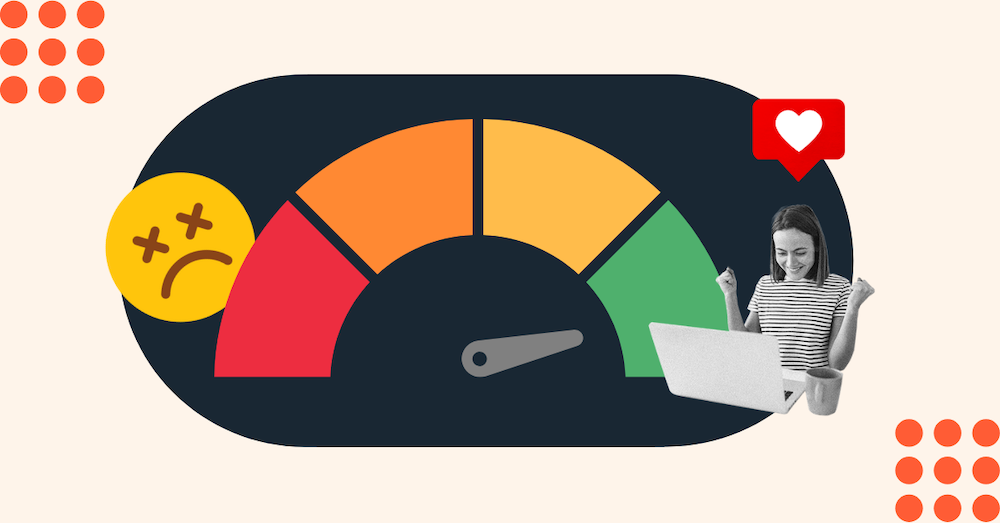




![How To Design Customer Satisfaction Surveys That Get Results [+ Templates]](https://53.fs1.hubspotusercontent-na1.net/hubfs/53/customersatisfactionsurvey.webp)
